
AAVMC/APLU Gene Editing Task Force Recommends ‘Remodeling’ Federal Regulatory Landscape
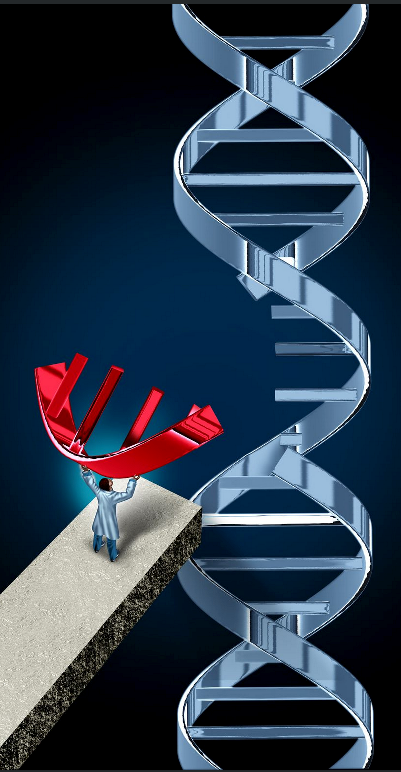
Gene editing in agricultural animals has the potential to unleash enormous gains in productivity. But in order for those gains to be realized, “a remodeling of the federal regulatory landscape is needed.” That’s the conclusion of a panel of experts convened by the AAVMC and the Association of Public and Land-grant Universities (APLU) that spent the past 18 months studying the issue.
The “AAVMC/APLU Gene Editing in Agriculture Task Force Report” suggests current regulatory protocols have not kept up with technological change and must be modernized in order for society to realize the many benefits of new scientific capabilities. Regulatory reform will help address the food security and sustainability needs of a global population expected to reach 10 billion people by 2050.
“For the promises of applying gene editing in livestock to be realized, federal regulatory approval and monitoring processes that are rooted in science and streamlined with the pace of development, as well as public acceptance of food derived from gene edited animals, are essential,” authors say in the report. “Thus, a remodeling of the federal regulatory landscape is needed for the U.S. to sustain its place as a global leader and innovator in the animal agriculture sector and keep pace with the exponentially expanding global human population.”
Currently the Food and Drug Administration regulates genetic work on food animals as an “animal drug” under protocols developed during the early phases of the Biotechnology Revolution. The USDA regulates these technologies with crops.
The report contains several specific recommendations for regulatory officials and lawmakers to consider as they envision “what a modernized and progressive framework for the regulation of gene edited livestock in the U.S.” should be:
- Update the existing FDA regulatory framework (currently based upon processes established for transgenic technologies that are out of step with state-of-the-art gene editing technologies) and develop a coordinated, streamlined, fact-based, and cost-effective assessment and approval process between the USDA and FDA to ensure safe food.
- Develop an evidence and logic-based decision-making protocol for gene editing applications that is regulated separately from transgenic-based GMOs which result from the integration of recombinant DNA.
- Develop streamlined assessment and approval processes that categorize gene editing applications based on: a) the type of genomic change being created, b) the method used for creating the genomic change, c) the impact on the welfare of the animal, and d) the potential for negative impact on the environment.
- Develop a regulatory channel for approval of gene-edited agricultural animals with genomic structures that could have arisen in nature as safe for human consumption.
“Gene editing has the capacity to create transformational change in our food production systems,” said Dr. Noelle Cockett, president of Utah State University, a renowned geneticist, and chair of the task force. “But in order to realize those benefits in production and safety, we need a regulatory structure that has kept pace with technology. Our task force has thoughtfully and carefully considered many different aspects of this issue, including perspectives from the scientific and agricultural communities, and we have made our recommendations. We hope this work will meaningfully inform the work of government officials as they develop the best public policy in this area.”
For more than 10,000 years, humans have been using selective breeding in domesticated animals to achieve desired characteristics like improved growth and resiliency, according to the report. While it has been useful over the centuries, selective breeding is time consuming and requires multiple generations before results can be achieved.
The advent of biotechnology substantially advanced those capabilities. Following the invention of recombinant DNA technology, scientists were able to quickly produce generations of animals with desired characteristics by fusing strands of DNA that coded for those changes through a process known as transgenesis.
The genomic structure of transgenic animals could not occur in nature through normal mutagenic processes and transgenic animals were eventually regulated by the federal government as Genetically Modified Organisms (GMO’s). Public attitudes regarding the safety of GMO’s have wavered from uncertainty to negative, which has impaired the widespread use of that technology.
Meanwhile, scientific advancements led to the development of CRISPR technology (clustered regularly interspaced short palindromic repeats), which enables scientists to precisely “edit” existing strands of DNA in a way that immediately generates the desired genomic characteristics. Importantly, these genetic changes can and do occur naturally in the world through normal mutagenic processes.
“Both the technical science and intended outcomes of gene editing are substantially different compared to transgenesis,” according to the authors. “As such, regulatory statutes should not be applied as a ‘one size fits all’ model; rather, contextual categorizing of the genetically altered animals that allows for fluidity and applying logic-based decision making, while still ensuring safety, is needed.”
The expert panel also outlined a series of steps that could pave the way for fully reaping the potential benefits of gene editing technology:
- Establish a national coalition of scientific experts, bioethicists, and engagement specialists from APLU and AAVMC member institutions to serve as a sounding board and think-tank related to the modernization of the existing federal regulatory framework.
- Engage with federal legislators, staffers, and the White House Office of Science and Technology Policy (OSTP) and inform them on key issues related to regulatory approval and monitoring processes for gene editing applications in livestock.
- Distribute the task force report to stakeholder organizations and agencies like U.S. Land-grant universities, the FDA, the USDA, the Food and Agricultural Organization (FAO) of the United Nations, the Gates Foundation, and others.
- Establish a University Research Consortium of scientific experts developing gene editing applications in livestock that will facilitate collaborative research and educational initiatives.
AAVMC/APLU Gene Editing in Agriculture Task Force members include Cockett; Dr. Jon Oatley, Washington State University; Dr. Bhanu Telugu, Universities of Missouri and Maryland; Dr. Londa Nwadike, Kansas State University and University of Missouri; Dr. Jonathan Beever, University of Tennessee; Dr. Rex Dunham, Auburn University; and Dr. James Murray, University of California, Davis; Dr. Kathy Simmons, National Cattlemen’s Beef Association; and Clint Nesbitt, Biotechnology Innovation Organization (BIO). The task force was staffed by AAVMC Director for Governmental Affairs Mr. Kevin Cain.
“We’re pleased to partner with the APLU on a project that has such vast implications for agricultural productivity and food security,” said AAVMC CEO Dr. Andrew T. Maccabe. “Working closely with other stakeholders and thought-leaders and using evidence-based facts, scientists working in our member institutions have been able to make an important contribution in a converging area of science, technology and public policy that needs to be addressed.”
“Gene editing is a key tool in our effort to foster greater food security across the world and produce healthier, more sustainable food,” APLU President Peter McPherson said. “Having a regulatory framework to ensure the safety and integrity of such food is important, but the current system is outdated and not constructed to deal with the modern state of gene editing technology and processes. In partnering together, our nation’s public and land-grant universities and veterinary colleges have charted a path forward that will allow this field to advance while maintaining appropriate and effective oversight.”
The APLU and the AAVMC decided to take action in this area following inquiries from members of Congress to then Food and Drug Administration Acting Commissioner Norman E. Sharpless concerning current regulatory processes. That provided the impetus for the AAVMC and the APLU to organize a fall 2019 symposium for leading scientists and other scholars called “Gene Editing in Livestock: Looking to the Future.” During that event, 23 of the nation’s leading experts from academia, government, industry, and professional groups gathered to examine a series of questions ranging from the nature and safety of this promising technology to its ethical implications.
Symposium participants concluded that work with animal and plant genomes has vast potential for limiting disease and increasing productivity, but agreed that appropriate regulatory processes should be thoroughly considered and structured. That led to the formation of the task force.
The APLU and the AAVMC previously teamed up on a multi-year effort designed to address the growing antimicrobial resistance problem. That led to the establishment of the National Institute of Antimicrobial Resistance Research and Education (NIARRE), which is based at Iowa State University and operates in collaboration with a consortium of partner universities and medical institutions.
The APLU is a research, policy, and advocacy organization dedicated to strengthening and advancing the work of public universities in the U.S., Canada, and Mexico. With a membership of 244 public research universities, land-grant institutions, state university systems, and affiliated organizations, APLU’s agenda is built on the three pillars of increasing degree completion and academic success, advancing scientific research, and expanding engagement. Annually, member campuses enroll 5.0 million undergraduates and 1.3 million graduate students, award 1.3 million degrees, employ 1.3 million faculty and staff, and conduct $49.2 billion in university-based research.
The GRE: Does it Predict for Success in Veterinary Medical School?

A recently published research review on the AAVMC website suggests that using the Graduate Record Examinations (GRE) as an admissions tool for professional degree programs in veterinary medicine disadvantages underrepresented student applicants.
The use of the exam in graduate and professional school admissions has long been a mainstay, and about 75% of U.S.-based AAVMC member institutions still use GRE scores in admissions. Evidence collected since 1990 has in fact demonstrated positive correlations between GRE scores and early academic performance, according to the report.
“Increasingly, though, the merits of GRE scores as a useful measure of academic and professional potential are being questioned and debated,” said Dr. James W. Lloyd, of Animal Health Economics, LLC, who worked with the AAVMC on the study.
The major problem with the GRE is that racial, gender-based, socio-economic and other biases built into the examination unfairly assess and underpredict the capacity and potential professional success of underrepresented minorities, women and others.
“At a time when advancing diversity, equity, and inclusion in veterinary medicine is at or near the top of the strategic priority list for virtually all veterinary medical organizations, whether academic or in the industry, this situation is extremely concerning,” writes Lloyd.
Much of the current thinking is grounded in a 2014 report published in Nature which outlined concerns about the GRE’s deficiencies based on inherent bias with the instrument.
“The race/ethnicity and gender biases are thought to have complex, cultural foundations while the socio-economic bias simply reflects a disparity in educational systems and in access to test-preparation resources based on financial means,” writes Lloyd.
The report says undergraduate GPA’s offer an alternative that are at least “as robust, consistent and reliable” as GRE scores, and experts agree those metrics are not distorted by the systemic biases reflected in GRE scores. Both of those tools, however, fall short of measuring some important attributes that should be considered in applicants.
Non-academic skills, knowledge, attitudes and aptitudes (SKA’s) necessary for success in professional practice include things like leadership, communications, critical thinking, problem solving, teamwork, integrity, persistence and other personal attributes. These are believed to play a more useful role in predicting professional success.
Assessing those characteristics involves taking a more holistic approach to admissions and evaluating a broader spectrum of personal characteristics in candidates for admission.
“Continued reliance on GRE for admission decisions will be one important ongoing source of unintended institutional racism, sexism, classism, and/or elitism across academic veterinary medicine – imparting unintended bias against those candidates who might be marginalized based on race, ethnicity, gender, socio-economic status, or geography,” the report concludes.
“Admissions policies and processes constitute the gateway to the veterinary medical profession, and admissions committees inherently represent the gatekeepers,” writes Lloyd in the report. “In such a critical role, potential changes to admissions policies and processes clearly warrant careful, reasoned consideration based on structured, data-driven analyses.”
One useful approach to acquiring the data required to support the best evidence-based decision-making could be the establishment of a consortium of those AAVMC member institutions that have stopped using the GRE and collectively study any possible impact on student success, according to Lloyd.
Research Committee Building Community, Critical Mass

The pandemic has illuminated the critical importance of veterinary medical research for many people. But veterinary scientists have been pioneering new and better ways to diagnose, treat and prevent illness in both people and animals for more than a century.
Right now, about a half a billion dollars in research is underway at U.S. based AAVMC institutions, funded by organizations like the National Institutes of Health, the USDA, and many other agencies, corporations and foundations.
Developing strategies to support the success and growth of the research mission at AAVMC member institutions, exploring funding opportunities, and inspiring future students to consider career opportunities in research falls under the purview of the AAVMC Research Committee, which functions as an advisory group to the Board of Directors and the Assembly.
Commensurate with the development and implementation of the AAVMC’s new strategic plan, the Research Committee leadership surveyed committee members to solicit their views on strategic priorities, and a consensus emerged that one of the most important needs was to develop more collaboration, communication and a stronger sense of community among veterinary medical researchers at AAVMC institutions.

Led by Dr. Lois Hoyer, professor of pathobiology and associate dean for research and advanced studies at the University of Illinois College of Veterinary Medicine, the Research Committee is moving quickly toward that goal.
“Exploration, discovery and innovation form the nucleus of problem-solving and opportunity-creation,” said Research Committee Chair Dr. Lois Hoyer, professor of pathobiology and associate dean for research and advanced studies at the University of Illinois College of Veterinary Medicine. “Over the decades, researchers working within AAVMC member institution laboratories have made remarkable contributions to human and animal health and their work has never been more important. Our goal with increased collaboration is to create a whole that is greater than the sum.”
The AAVMC Research Forum was established as a community of interest in March 2020. Since then, the forum has grown to include 79 members and more than 100 observations, queries and comments have been posted.
The group has also been active with Zoom meetings. Meetings with more than 25 attendees each have been held over the past several months featuring topics like promoting clinical scientist training, research technology commercialization, and industry engagement.
The group is also working to increase engagement and create more value for international members. An International Representative to the Research Committee leadership team was added in March 2020. The Research Committee is also playing a more instrumental role in the presentation of research related programs like the National Veterinary Student Scholars symposium.
The Research Committee is comprised of the Associate and Assistant Deans for Research from each AAVMC Member, Collaborative, and Provisional Member; and the Director from each Affiliate Member institution.
In addition to Dr. Hoyer, the Research Committee leadership team includes Dr. Molly McCue, Associate Dean for Research, University of Minnesota College of Veterinary Medicine, Chair-Elect; Dr. Kathryn M. Meurs, Associate Dean of Research and Graduate Studies, North Carolina State University College of Veterinary Medicine, Past Chair; and Dr. Larry Hammell, Associate Dean – Graduate Studies & Research, Atlantic Veterinary College, University of Prince Edward Island, International Representative. AAVMC Senior Director for Academic and Research Affairs Dr. Ted Mashima serves as staff liaison.
Journal of Veterinary Medical Education Now a Hybrid Open Access Model
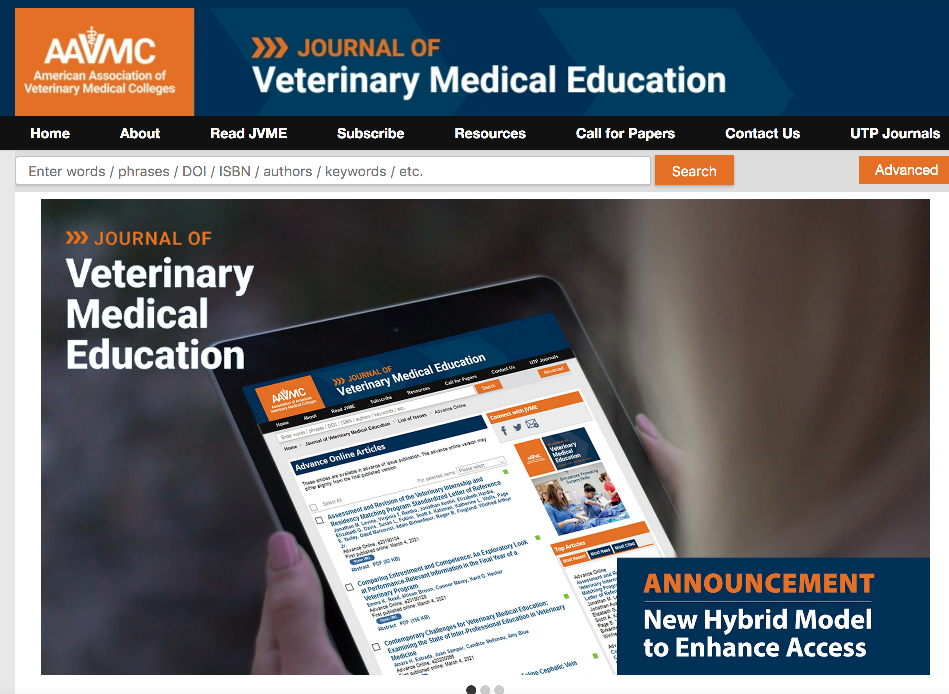
The AAVMC and the University of Toronto Press are pleased to announce that the Journal of Veterinary Medical Education (JVME) has adopted a hybrid print and online publishing model which incorporates open access of all published content. Effective July 1, all JVME content is published with a 12-month open access embargo and all issues published up to and including volume 47 issue 3 (June 2020) are now open access at https://jvme.utpjournals.press/.
This change expands access to important developments in veterinary medical education. JVME’s transition to a hybrid publishing model amplifies its global reach to veterinary medical practitioners, educators, researchers, prospective and current veterinary medical students and other stakeholders.
Under the new model, JVME will maintain a rolling 12-month embargo on new issues. Based on the date of issue publication, and at no cost to authors, all articles will become open access directly on the journal’s website 12 months after publication. During the first 12 months of publication, content will remain available to members of the AAVMC and by subscription to both library and individual customers. Faculty and students of AAVMC member institutions and subscribing libraries have access to all content available by subscription.
As an additional option, authors may choose, with payment of a fee, to publish individual manuscripts using the gold open access model, whereby the manuscripts will be published open access immediately after acceptance, without an embargo. The journal’s Advance Online feature will be maintained under the new model.
Shifting the JVME to a hybrid model will foster AAVMC’s goals of building public awareness of the ways veterinary medicine is advancing global health and wellbeing; promoting careers in veterinary and biomedical research among students, applicants and pre-applicants; and supporting engagement, sharing and collaboration among AAVMC member institution research administrators.
Increased visibility and more timely access to the research presented in JVME will also promote interprofessional collaboration and improve outreach to the media and policy-makers, further increasing the impact of JVME and its authors on international veterinary medicine.
While addressing the rapidly changing world of veterinary medicine, JVME remains strongly committed to ensuring that the highest ethical standards are honored in all areas of published research. Rigorous peer-review processes will maintain the high-quality trusted research for which JVME is known and respected.
This move is the latest effort in JVME’s mission to continuously improve its service to the academic veterinary medical community. In 2020, JVME increased the annual number of issues published from four to six in response to the steady increase of high-quality scholarly manuscripts and the need for rapid access to crucial research within the veterinary medical education field.
Wisconsin Wins AAVMC’s 2021 Communications Excellence Award

The communications team at the University of Wisconsin School of Veterinary Medicine has been awarded the 2021 AAVMC Communications Excellence Award.
Wisconsin was recognized for overall programmatic excellence and an historic 2020 Super Bowl commercial featuring their world class veterinary oncology program. That spot reached a live audience estimated at more than 100 million people and generated 2.56 billion media impressions.
“I would argue that there has never been a broader reach to the world’s public highlighting the impact and importance of veterinary medicine on both animal and human health,” wrote UW-SVM Dean Dr. Mark Markel in an introductory letter that outlined the massive amount of logistics required to mount the effort and assessed the impact.
The rare opportunity for academic veterinary medicine crystalized when WeatherTech Corporation owner David McNeil decided to produce and air a commercial during the 54th Super Bowl detailing the saga of his beloved seven-year-old Golden Retriever Scout, who was suffering from a cardiac tumor.
The “Lucky Dog” ad played during the 2020 Super Bowl, the CBS special “Super Bowl Greatest Commercials,” and generated stories on major media including NBC Nightly News, ABC’s World News Tonight, NPR’s Morning Edition, NBC’s Today Show, People Magazine and many more.
UW’s Communications and Marketing Manager Ashley Voss and Publications and Media Relations Manager Meghan Lepisto led efforts to support the commercial with production assistance, media outreach, a viral social media campaign, and a special, virtual event.
Markel said the extraordinary opportunity surrounding the Super Bowl commercial was just the beginning of a year that encompassed many communications challenges. “Ashley and Meghan led the school’s communication around veterinary medicine’s impact on both animal and human health but then also excelled in our communication strategies around social justice, response to the COVID-19 pandemic and funding for the school’s expansion project.”
“Our success on this front was in no small part due to Ashley and Meghan’s continued and successful strategic thinking about how we should communicate with our stakeholders,” said Markel.
The communications staff also played an important role in building support and awareness for a six-year capital campaign that generated resources to help construct a $150 million expansion to the school’s physical plant, which is now underway.
The award will be formally presented during the annual meeting of the Association of Veterinary Advancement Professionals (AVAP), to be held virtually on July 27.
A team of five communications professionals representing various organizations in the Washington, D.C.-based Federation of Associations of Schools in the Health Professions (FASHP) judged the award.
Founded in 2013, the AAVMC Communications Excellence Award is designed to recognize the important role communication programs play in advancing academic veterinary medicine and the profession.
UC Davis Wins AAVMC’s 2021 Fundraising Excellence Award

The advancement team at the UC Davis School of Veterinary Medicine has been awarded the 2021 AAVMC Award for Fundraising Excellence in Student Scholarships.
The award seeks to advance the AAVMC’s strategic interest in achieving increased philanthropic support for DVM student scholarships at member institutions.
The winning team at UC Davis, led by Interim Assistant Dean of Advancement Debbie Wilson, introduced several new initiatives to elevate an ongoing program that provides $7.6 million in annual financial assistance to its approximately 600 Doctor of Veterinary Medicine (DVM) students.
Those included retooling the donor stewardship program and working with 450 student scholarship recipients to send new appreciation packets, which resulted in additional gifts.
They also established the UC Davis School of Veterinary Medicine Hardship Fund, which now provides emergency financial assistance for currently enrolled DVM students, MPVM students, PhD students and veterinary House Officers experiencing a serious and unexpected financial hardship that threatens their ability to stay enrolled. That program was launched during the school’s “Give Day” event on April 17-18, 2020.
“As a result of the advancement team’s work our school has kept veterinary school affordable, which provides benefits to society,” wrote former Dean Dr. Michael Lairmore. “Graduates with low debt have greater flexibility to pursue advanced scientific or clinical training, which leads to better patient care, and scientific and medical breakthroughs, as well as pursue public service careers.”
In the AVMA’s 2020 Economic State of the Veterinary Profession, the UC Davis School of Veterinary Medicine was found to have the most optimal debt-to-income ratio of the U.S. based schools at 0.8, and the second-least median debt of any of the 30 schools, according to Lairmore. And even that’s improving.
“In the most recent figures available, our student debt declined 19% by median and 10% by mean when comparing 2018 to 2019 UC Davis graduates,” Lairmore wrote. “Student debt for these new graduates came in at a median of $96,958 compared to $120,250 from the previous year’s graduates and a mean of $91,486 compared to $101,328. These impressive advances were made possible by the exceptional work of our advancement team.”
The awards will be formally presented during the annual meeting of the Association of Veterinary Advancement Professionals (AVAP), to be held virtually on July 27.
Founded in 2018, the AAVMC Award for Fundraising Excellence in Student Scholarships is designed to inspire and recognize professional excellence and achievement in fundraising for DVM student scholarships among member institutions.
FFAR Awards Third Cohort of Vet Fellows
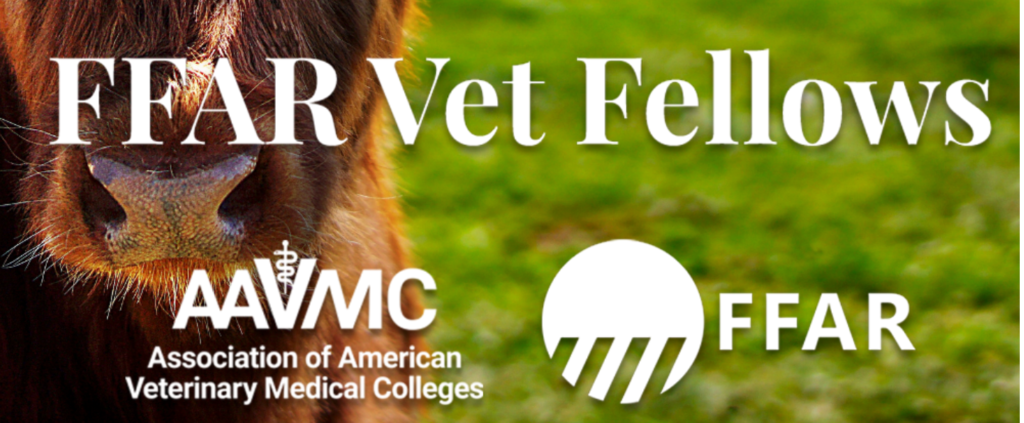
The Foundation for Food & Agriculture Research (FFAR) is excited to announce the fourteen recipients of the 2021 Veterinary Student Research Fellowships (Vet Fellows) in partnership with the AAVMC. This fellowship creates opportunities for veterinary students to pursue research on global food security and sustainable animal production.
The FFAR Vet Fellows program invests in future veterinarians and provides the opportunity to pursue research expertise outside of the traditional biomedical course. Veterinarians trained in multi-species medicine, animal science and public health are key to addressing many real-world challenges. The three-month fellowship culminates with student presentations at the annual National Veterinary Scholars Symposium in August.
The FFAR Vet Fellows program supports student research on agricultural productivity, public health and environmental sustainability. FFAR and AAVMC adjusted the parameters of the fellowship in response to the COVID-19 crisis to also include zoonotic or pandemic research. Due to the urgent nature of this research, the Vet Fellows were not required to provide matching funds. The 2021 Vet Fellows are also not required to provide matching funds, allowing them to focus exclusively on their research.
“Investing in the development of our scientific workforce is a cornerstone of FFAR’s mission,” said FFAR’s Advanced Animal Systems Scientific Program Director Dr. Tim Kurt. “We are thrilled to support the research of the Vet Fellows this year who are developing tools, technologies and strategies to solve real-world issues affecting animal production, disease evolution and animal and human health.”
“We’re honored to work with FFAR again on this important program,” said AAVMC CEO Dr. Andrew T. Maccabe. “The experience students gain through these Veterinary Student Research Fellowships inspires them to consider careers in agricultural and veterinary medical research. Many make significant contributions in addressing major problems in food production, food security and public health.”
The 2021 FFAR Vet Fellows include:
Kim Nguyen
University of Minnesota College of Veterinary Medicine
The Center for Animal Health and Food Safety at the University of Minnesota developed an event-based biosurveillance system that helps prevent the introduction of foreign pathogens into the US by gathering and analyzing data on environmental health sources. Nguyen is evaluating the impact of this system and contrasting its sensitivity to other global surveillance systems used for monitoring emerging animal diseases.
Stefan Keller
University of Missouri
Anaplasma and Babesia are tick-borne bacteria in cattle that can cause severe anemia in livestock. These pathogen-caused diseases can impact ranchers’ livelihoods and nutritional security globally. Keller’s work aims to better understand cattle’s immune response to ticks, with the goal of identifying molecules that may be ideal vaccine candidates for blocking pathogen transmission.
Carmen-Maria Garcia
Michigan State University
Livestock are exposed to a multitude of environmental and social stressors, which impact health, wellbeing and performance. Early weaning (EW) in swine production is linked with increased disease risk and reduced performance over the pig’s lifetime. How EW practices lead to long-term disease vulnerability is unknown and targeted interventions are lacking. Garcia’s research is examining whether EW pigs’ immune systems exhibit stress-induced glucose use, which could drive inflammation and increased disease risk.
Daniella Burleson
Texas A&M University
Nontyphoidal salmonella infections, caused by the bacterium Salmonella enterica, are a significant public health problem in the US. Characterized by symptoms such as nausea, diarrhea and vomiting, nontyphoidal salmonella infections can spread to humans who eat contaminated animal products. Burleson is using droplet digital PCR (ddPCR) technology, a technique that partitions nucleic acid samples into thousands of droplets and amplifies DNA or RNA targets, to detect and quantify antimicrobial resistance genes in nontyphoidal Salmonella enterica from cattle fecal samples. This work helps researchers better understand antimicrobial resistance in animals and the environment.
Hannah Knight
Mississippi State University, College of Veterinary Medicine
Macrophages are specialized immune cells that detect and respond to harmful bacteria. Knight is analyzing whether exposure to beta-glucans boost macrophage function in fish to achieve immunity equivalent to vaccination. Knight is using next generation sequencing, a technique that reads DNA sequences in small fragments and reassembles them to create a complete sequence, to evaluate gene expressions that strengthen immunity. Methods to boost innate immunity can enhance disease resistance, improving animal health and production efficiency.
Courtney Wangler
University of Illinois at Urbana-Champaign
Influenza A virus (swine flu) is an endemic pathogen of pigs that can cause significant illness and is difficult to control. Wangler’s research seeks to develop a rapid, low-cost test to determine the presence of influenza A in swine herds, enabling appropriate disease control interventions.
Chalise Brown
North Carolina State University College of Veterinary Medicine
Salmonellosis is an infection of the digestive tract caused by the bacterium Salmonella enterica that can cause illness in cattle and humans. Neutrophils, a type of white blood cell, causes inflammation that can enable salmonella to colonize the digestive tract. Brown is assessing how blocking a host protein that regulates neutrophil function will alter salmonella-induced neutrophil inflammatory functions. This research is determining if the host protein is a viable therapeutic target for combating tissue damage resulting from diseases like salmonellosis.
Jimmy Guan
Western University of Health Science
Administering enzyme supplements in poultry is a longstanding practice thought to increase meat and egg production. Guan is evaluating enzymes that break down non-starch polysaccharides (NSPases), complex carbohydrates that that can improve energy use and feed efficiency of broiler chickens. An Aspergillus spp. known to produce these NSPases were fed to a group of chickens in addition to the purified enzyme. Guan is evaluating how purified NSPases and Aspergillus-produced NSPases impact the gut microbiome, research that could improve animal performance without the use of antibiotics.
Bailey Carpenter
University of Pennsylvania
Food production in West Africa relies on rain-fed agriculture, which is a challenge considering climate change, informal and sometimes unreliable markets and competition with imported food products. Strategies to reduce production and economic risks can improve financial returns for smallholder farmers. Carpenter is creating a model for poultry production that captures poultry health, nutrition, biosecurity and commercial sales, as well as related financial projections for testing, at a teaching and research farm in The Gambia.
Derek Jantzen
University of Wisconsin-Madison
Imaging technology and artificial intelligence may predict mammary gland (responsible for milk production) growth and milk production of heifers, female calves, prior to their first lactation. Jantzen is further developing a radio frequency identification (RFID)-camera system to evaluate image-based body weight modeling for heifers and developing an automated system to analyze ultrasound images from the mammary grand. He is combining body measurements and the ultrasound image assessment of mammary glands with genomic information to predict reproduction and production performance.
Corrin Markey
Virginia-Maryland College of Veterinary Medicine
Brucellosis, Q fever and MERS-CoV are severe zoonotic diseases that affect camels and can spread to humans. Markey is compiling baseline information that local animal health authorities in Samburu, Kenya can use to formulate, implement and evaluate disease control and preventive measures for these infectious diseases in camels. Additionally, Markey is estimating the level of pathogens that can cause these diseases and identifying exposure factors associated with positive brucellosis, Q fever and/or MERS-CoV antibodies in camels.
Anna Schaubeck
Long Island University
The American lobster is an economically important commodity for the US shellfish industry. Epizootic shell disease (ESD) is an infection on the shell, which can lead to secondary infections or death. This emerging disease is associated with warming seawater temperatures, caused by climate change. Schaubeck is using computational tools to identify ESD-associated microbiota changes in American lobsters and genes that are associated with protection against ESD. This work protects a valuable industry from changing climate impacts.
Ashley Rasys
University of Georgia
Current gene editing methods are often expensive and time-consuming. Rasys developed a more efficient and affordable gene editing approach that she used to successfully create the world’s first genetically modified reptile. Rasys is adapting this technique to mutate a gene to cause albinism in chickens, which involves microinjecting CRISPR, a technology to edit genes, directly into adult female unfertilized eggs. Editing genes in birds has been notoriously difficult using CRISPR or other genome editing tools, yet these technologies have huge potential for improving animal health and welfare in poultry, the food animal species with the fastest growing global demand.
Jayden McCall
Kansas State University
African swine fever virus (ASFV) causes a highly contagious and deadly disease of swine for which there is no vaccine. McCall is identifying protective antigens, viral proteins that produce a protective immune response in the body, within the ASFV genome. This information is critical to developing an efficient vaccine against ASFV, greatly benefitting global pork producers.
The Foundation for Food & Agriculture Research (FFAR) builds public-private partnerships to fund bold research addressing big food and agriculture challenges. FFAR was established in the 2014 Farm Bill to increase public agriculture research investments, fill knowledge gaps and complement USDA’s research agenda. FFAR’s model matches federal funding from Congress with private funding, delivering a powerful return on taxpayer investment. Through collaboration and partnerships, FFAR advances actionable science benefiting farmers, consumers and the environment.
For more information contact Colleen Klemczewski at cklemczewski@foundationfar.org or 574-386-0658.
AVMA/AAVMC Joint Committee Meets in Washington

The AVMA/AAVMC Joint Committee convened for their semi-annual meeting in June in Washington, D.C.
Comprised of senior leaders from each organization, the committee exists to foster collaboration, common understanding and strategic alignment on issues and opportunities in the veterinary medical profession.
Presentations and discussions were held on Diversity, Equity, and Inclusion (DEI); wellbeing, leadership and professional development, economic issues, advocacy, veterinary technicians, accreditation and other areas.
The origins of cooperation between the two major veterinary medical organizations run deep. They have held regular meetings since the AAVMC was established as a formal independent organization in 1966.
Prior to that an organization founded in 1937 called the Association of Deans of American Colleges of Veterinary Medicine met as a component of the AVMA’s former Committee on Education.
That group was founded upon the foundation of the AVMA’s Committee on Intelligence and Education. Founded in 1928, the committee was required to include three faculty members.
Lincoln Memorial University Introduces World’s Second Masters in Veterinary Education Program
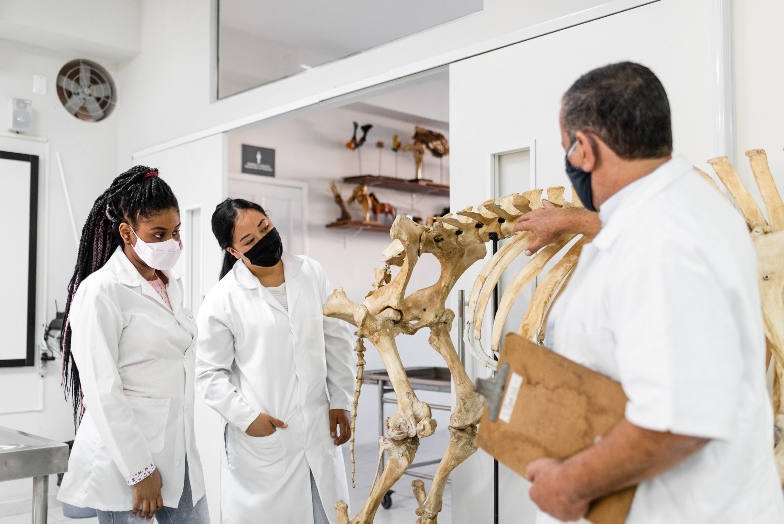
The Lincoln Memorial University College of Veterinary Medicine (LMU-CVM) has introduced a new Master of Veterinary Education (MVEd) degree program. It’s the first of its kind in the United States and the second of its kind in the world, according to school officials.
The program is focused on providing veterinary professionals with teaching skills and academic credentials that will better prepare them for teaching veterinary medicine in higher education. LMU-CVM is accepting applications now for a start date of August 2021.
The new MVEd program is offered completely online and allows students to earn their graduate degree in education at their own pace. The full-time program can be completed within two years.
“With the ever-growing need for qualified veterinarians, we must ask the question, ‘who will teach the next generation?’” said LMU-CVM Dean Stacy Anderson. “Our program addresses unique challenges faced in veterinary education and prepares future professors in the best way to help budding veterinarians learn in the classroom and the clinic.”
The Royal Veterinary College in London also offers a MSc degree in Veterinary Education as part of a portfolio of available coursework in veterinary education at the post-graduate level. Students can elect to undertake a 60 credit postgraduate certificate program, a 120 credit postgraduate diploma program, or a 180 credit MSc program at the RVC.
For more information on LMU’s MVEd program visit vetmed.LMUnet.edu or contact the program director, Katherine Fogelberg, at Katherine.fogelberg@LMUnet.edu.
AAVMC Observing National Minority Mental Health Awareness Month in July

The AAVMC is pleased to observe National Minority Mental Health Awareness Month this July. Sponsored by the Department of Health and Human Resources’ Office of Minority Health, the observance is designed to help eliminate the stigma associated with mental health issues in minority populations and underscore their lack of access to adequate mental health services. This website contains detailed information about some of the unique health disparities affecting African Americans, American Indians, Hispanic/Latinos, Pacific Islanders and other minority groups, as well as some of the resources available to help address the problem. The AAVMC has produced a monograph titled Integrating Racial & Multicultural Inclusion into Academic Wellbeing Initiatives, which provides a number of useful insights.
Academic Veterinary Medicine in the News
COVID-19 Pandemic Magnifies Workforce Crisis in Veterinary Field
CNN/News 7 Boston
Woman Admitted to Veterinary School Plays TikTok Trick to Surprise Her Family
The Today Show
Still Broken, Five Years After Fix the Debt Veterinary Summit
VIN
Purdue Shows Freezing Price of Veterinary School is Possible
VIN
Pinpointing How Cancer Cells Turn Aggressive
Technology
She Studies What Dogs Can Teach us About Our Own Language
Philadelphia Inquirer
How Can We Prevent the Next Zoonotic Disease Outbreak?
Modern Farmer
Study Sheds Light on Antimicrobial Use in US Wean-to-Market Pigs
The Pig Site
OSU Study: Compound Derived from Hops Shows Promise as Treatment for Common Liver Disease
News Channel KTVZ
Is Cattle Behaviour a Clue to Their Health? A U of S research Project Aims to Find Out
CTV News
Working With Dangerous Viruses Sounds like Trouble – but Here’s What Scientists Learn from Studying Pathogens in Secure Labs
The Conversation
Win-Win at Westminster for Cornell Veterinarians, Elite Dogs
Canine Chronicle
Ankle Replacement Offers Relief for Florida Pooch
Veterinary Practice News
K-State Virologists Publish New Findings On SARS-CoV-2 Treatment Option
Sunflower State Radio
A Dog Disease Resembling Human Multiple Sclerosis May Help Treatment for Both, Penn Vet Study Suggests
Philadelphia Inquirer
Pets Can Catch Covid From Owners, Study Suggests
BBC News
Researchers Rely on Genomic Surveillance to Understand Variants
NBC 15
From Our Members
Reflections of Gratitude (Thoughts from Former UC Davis Dean Dr. Michael Lairmore)
UC Davis
Texas A&M Veterinarians Transform Landscape Of Pituitary Gland Surgery
Texas A&M
Mississippi State’s Khaitsa Named to Global One Health High-Level Expert Panel
Mississippi State
Veterinarian, Rear Admiral, and Assistant Surgeon General Estella Jones Is Using Her Experience Combating Global Health Threats to Help the Nation Address the COVID-19 Crisis
Louisiana State University
PetSmart Charities® Grant Supports Animal Care & Education Opportunities at Ross University School of Veterinary Medicine
Ross University
Transdisciplinary Collaborations Essential to Tackling Cancer
Virginia Tech
UW School of Veterinary Medicine Breaks Ground on Building Expansion
University of Wisconsin
Using Gene Drives to Control Malaria
UC Davis
Newly Funded: Enhancing MRI Methods to Better Understand Disc Health, Risk of Future Herniation in Dogs
University of Minnesota
Living With Bats
Colorado State University
A Tale of Two Surgeries
University of Pennsylvania
To see a news feed featuring breaking news from our member institutions, please click here.
People in Motion
Dr. Oliver Garden has been appointed Dean of the LSU School of Veterinary Medicine, effective Aug. 31.
Dr. Gillian Muir became Dean of the Western College of Veterinary Medicine at the University of Saskatchewan, effective July 1.
Dr. John Pascoe has been appointed as Interim Dean of the UC Davis School of Veterinary Medicine.
Dr. Anne Marie Carey has been appointed Associate Dean of Academic and Student Affairs at the University of Prince Edward Island (Atlantic Veterinary College).
Dr. Amanda M. House has been named Associate Dean for Academic and Student Affairs at the University of Florida College of Veterinary Medicine.
Dr. Alejandro Ramirez has been named Senior Associate Dean for Academic Programs and Faculty Affairs at the University of Arizona College of Veterinary Medicine.
“Like” us on Facebook or follow us on Twitter, LinkedIn, and Instagram:




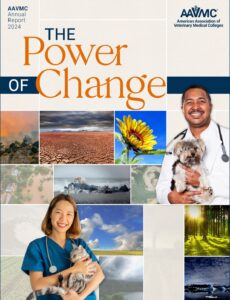




SHARE